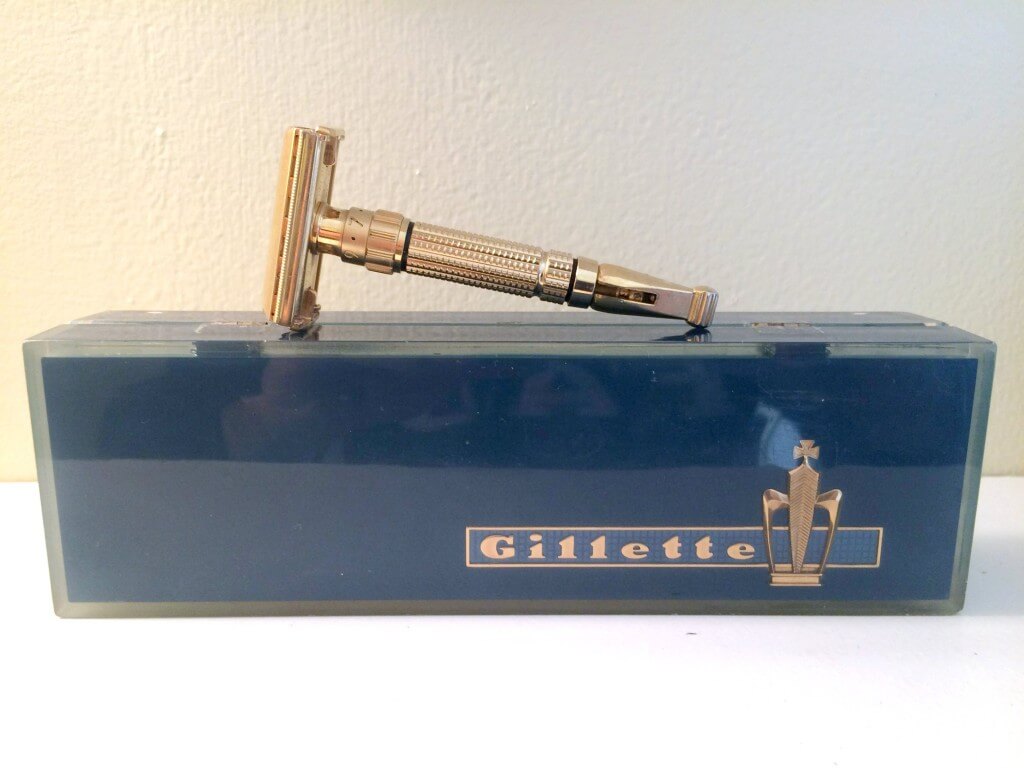 The Gillette Super Adjustable aka “Toggle” has always been viewed as one of the wet shaving “grails” to both users and collectors alike. Its unique opening/closing mechanism, and limited production has turned the toggle into one of the most collectable razors of all time.
The Gillette Super Adjustable aka “Toggle” has always been viewed as one of the wet shaving “grails” to both users and collectors alike. Its unique opening/closing mechanism, and limited production has turned the toggle into one of the most collectable razors of all time.
What makes the Toggle so cool? Well, there’s two contributors. First, the way the razor opens and closes to change blades. The unique “toggle” lever was designed to open and close the head of the razor instantly as opposed to previous models that required the user to twist the handle several times to change blades. This not only made blade changes quicker, it also made and cleaning the razor easier. A simple flick of the toggle lever and the razor could be rinsed and another flick would open it up.
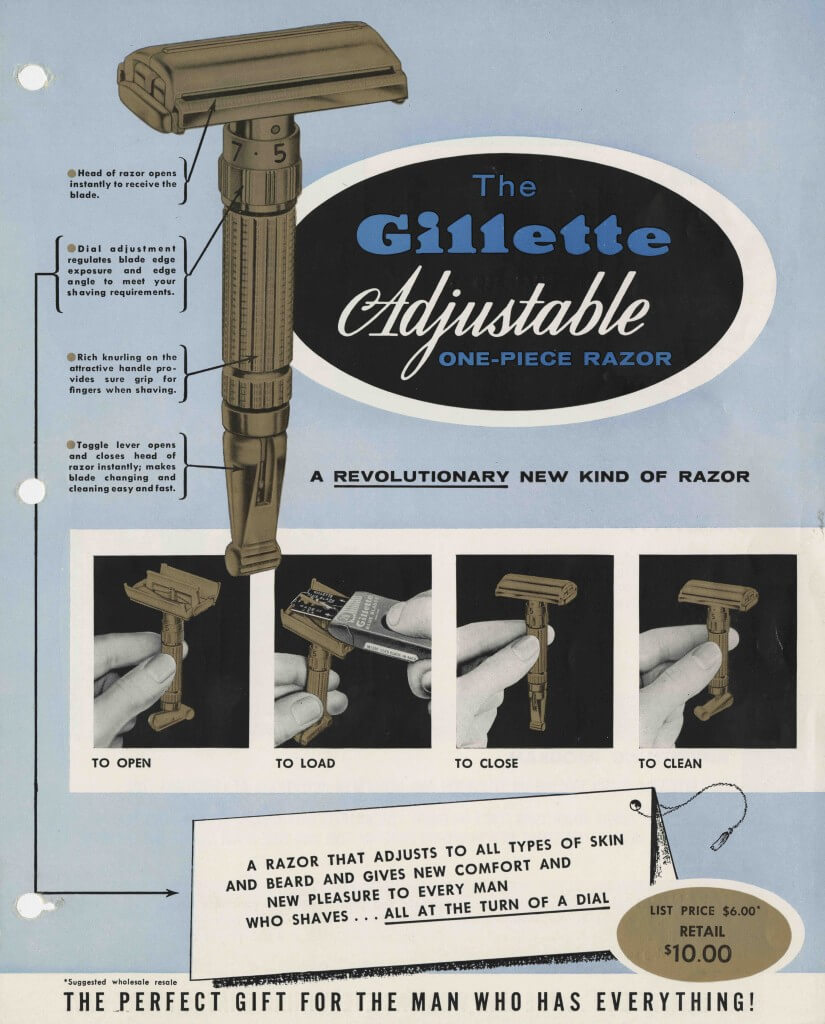
The second contributor was the adjustment dial. This dial was designed to customize the blade edge exposure and the blade angle to the user’s preference. Those who wanted a milder shave could use a lower setting and those who wanted a more aggressive approach could choose a higher setting. This was a brand new concept for Gillette and became the staple for Gillette DE (double edge) safety razors well into the 1980s.
The Toggle may be one of the most recognizable vintage razors, but they still remain a mystery. It seems that every few years or so a different previously unknown version of the Toggle emerges into the hands of a lucky collector, which baffles the minds of experts and collectors alike.
A few months ago I wanted to find out more about the mysterious Toggle and I contacted Procter and Gamble’s Senior Archivist Greg McCoy. Mr. McCoy is an expert in Gillette’s history was able to answer my questions and solve some of the mystery behind the Gillette Super Adjustable.
Types of Toggles
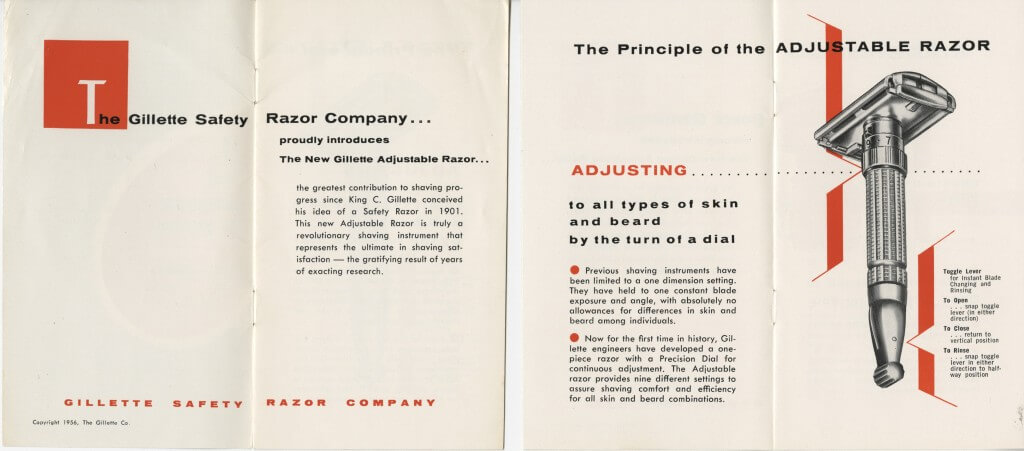
There are several known models/versions of the Super Adjustable that were produced from 1955-1960. Gillette tried their new adjustment feature in several models before it was perfected and distributed to the masses.
The first model had 5 adjustment indicators. These razors were adjustable to ½ of a click leaving 9 total adjustment options and came in a beautiful leather case. They were gold plated and originally thought to be identified only by serial numbers rather than the standard Gillette date code. Several years ago a gentleman found the actual date code underneath the blade bed while disassembling one for service. The code read “A-3” which means the razor was produced in the 3rd quarter of 1955. Most Gillette safety razors carry date codes that identify the year of production by letter and the fiscal quarter of production by number. There are many websites that have date charts to help identify production dates and here is one to get you started.
The second, is an extremely rare A-3 nickel plated model that had the same design as the gold model. There are less than a handful of them left which leads this model to bring some serious attention to online auctions. If you do find one, make sure you contact an expert to ensure its authenticity. There are many re-plated Toggles out in the wild and the last thing you want is to overpay or not get the full value of the razor.
The third is your standard Super Adjustable which was distributed to the masses. This razor was gold plated, featured the new 9 adjustment indicator and an impressive blue case. These razors carry a D-1 (1st quarter of 1958) date code and many were produced.
The fourth is a standard toggle that throws us all for loop. This model features the toggle design with a different blade tray and adjustment indicator with an external spring much like the limited “Bottom Dial.” This razor really reminisces a Fat Boy with the toggle lever rather than a standard Toggle. These razors came in different cases and were either nickel or gold plated. They had the F-4 (4th quarter 1960) date code.
Finally, in 1960 the final run of Super Adjustables hit consumers. These razors were identical to the D-1 razors distributed in 1958. They carried the F-4 date code and came with the same blue case as the 1958 model. This is by far the most produced Toggle.
If you want to learn more about the different models of Toggles check this out.
Concept of the Toggle
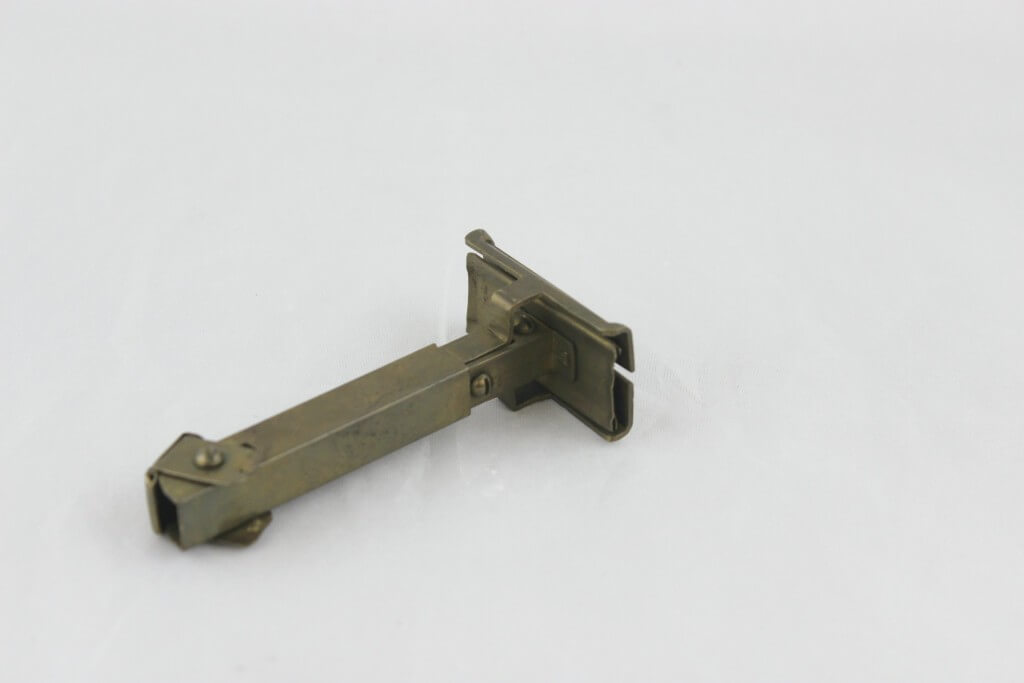
The actual concept for the Toggle’s opening and closing feature can be traced back to the 1930’s with the first prototype. This razor never made it to consumers and is the only one in existence. It features a very basic toggle design and was the first step in producing the quick and easy toggle feature. You won’t be able to purchase this one though, it’s locked up Gillette’s vault.
Fast forward to the mid-1950’s. Here is where Gillette decided to release their new adjustable toggle concept to several test markets. There were three known tests that were designed to perfect the new adjustable design and to see what consumers really wanted. The following will answer many of your questions regarding why the toggle was so limited and Gillette’s challenge to get an adjustable razor in the market.
First Test
The Gillette Toggle was deemed the “Gillette Super Adjustable” and was the first adjustable razor in Gillette’s line up. The first toggles were produced in 1955 and distributed to two test markets for Father’s Day of 1956.
The first market was located in Milwaukee and consisted of 2800 toggles that were sold for $7.50. Theses razors were the “A-3” toggles in the leather case that were mentioned previously in this article. This market was used specifically as a sales test to gather information regarding popularity and sales price. It was also used to see if consumers really enjoyed shaving with this new concept.
The second market located in Gillette’s home town of Boston consisted of a completely different test. The team at Gillette decided to gather 1100 men and divide them into four different groups. The first group consisted of 200 men that had both the “Toggle” and “Aqoss” razors. The term “Aqoss” was used by Gillette’s team as a test name for the standard adjustable prototypes that were being tested in addition to the Toggle. These were (TTO) or “twist to open” models and were similar in size and weight. You may have heard of them. These models started with the adjustment dial on the bottom of the razor and finished with the adjustment dial at the top. Today they are commonly known as the “Bottom Dial” 195 and 195 “Fat Boy”and are quite collectible. The second group of 300 men received only the toggle. The third group of 300 had the Aqoss razor only and the fourth had their choice of either.
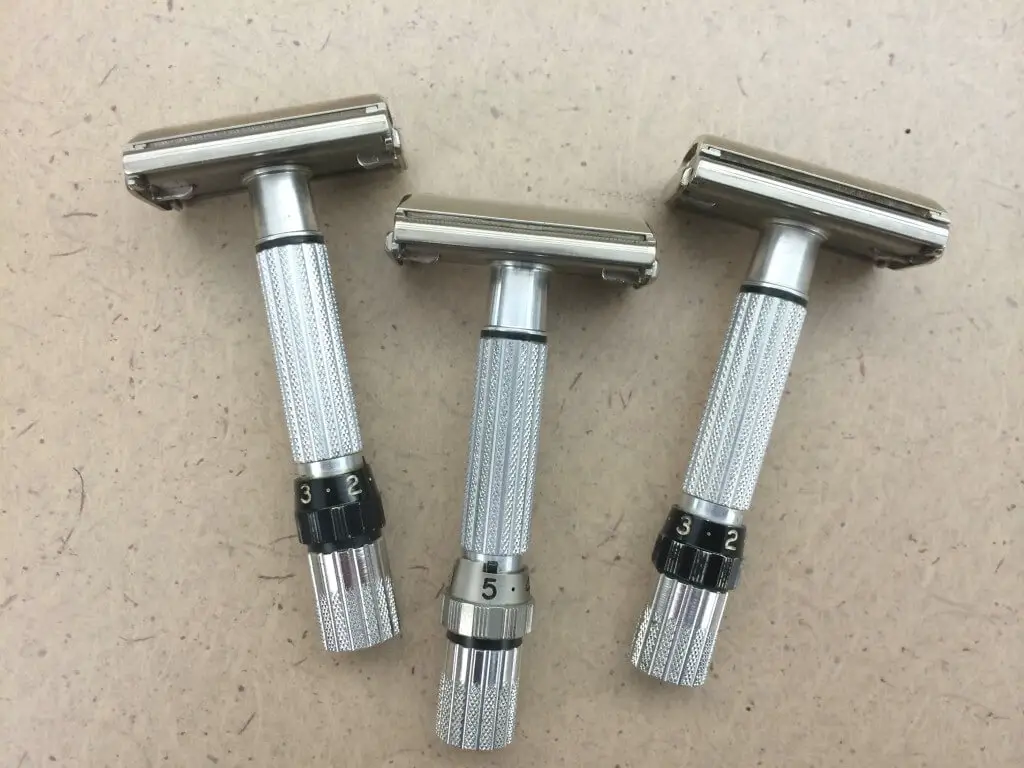
The Results
The Boston market produced very interesting results. 30% of users stopped using the Toggle and only 13% of them stopped using the Aqoss. Out of the users who had both razors 60% of them preferred the Aqoss. Some of the comments from the toggle was that it was too stiff, too heavy, the knurling was inadequate for wet hands, the handle was too long and that it was a tad confusing between the open and rinse positions. The concerns from the Aqoss razors was that the adjustment dial was too close to the TTO knob, and that the head of the razor loosened while shaving. The first market spoke, and it was obvious that the twist to open concept with the adjustment dial placed on neck of the razor was the desired design.
Second Test
The second trial run for the Toggle consisted of another sales test in Milwaukee. This test was performed in November of 1956 and March of 1957. Milwaukee was chosen for its size and population in relation to available toggles approximately which were 1547 units. Additional tests were performed and the results were recorded and sent to Gillette’s corporate team.
Final Test
Gillette listened to its test markets and came out with a new and improved toggle. The final test was performed during the Christmas season of 1956 in the Milwaukee and Fresno test markets. 5000 razors were produced that were lighter, shorter, had deeper knurling on the handle, had an improved toggle lever, a different case and now had 9 adjustment settings.
During this time it was mentioned in a particular memo that not all of the 5000 razors contained “registration” numbers and that they had the Aqoss adjustment dial that was still under development. The feedback from this test market exceeded that of the first test market and the Toggle was on its way to becoming nationally distributed.
In November of 1957 Gillette informed employees that the new adjustable will be available nationwide for Christmas of 1957 and will be Gold Plated with a 20 pack of blades for $10. By April 30, 1958 70,000 units were produced.
End of an Era
Many ask why the Toggle had such a short run for Gillette. The answer is simple: consumers preferred the twist to open design. Once Gillette moved the adjustment dial to the top, fixed the “loose door” problem and collaborated what they learned from the Toggle, the 195 Adjustable aka “Fat Boy” was born. The first 195s named for their selling price of $1.95 rolled off the line in October of 1958 and the rest is history. The Toggle was nationally distributed in the fourth quarter of 1960 before being discontinued for the more popular and cheaper 195 Fat Boy.
My Review 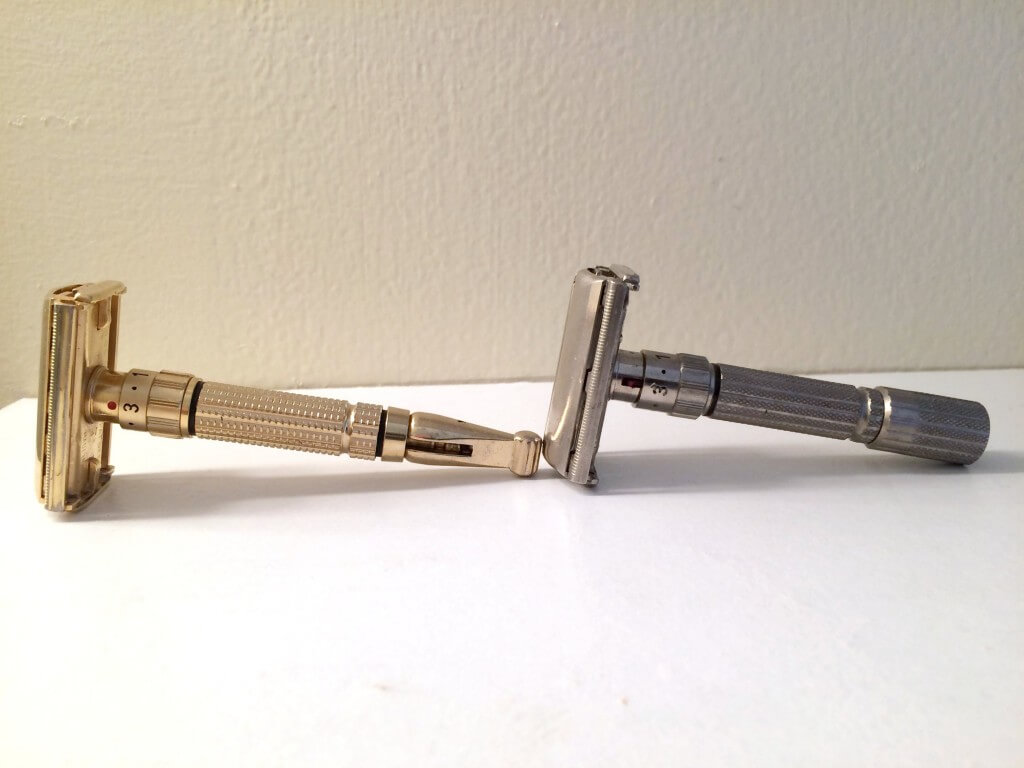
After my discussion with Mr. McCoy I decided to replicate the test with razors from my personal collection. Unfortunately, I do not own a Gillette Bottom Dial adjustable nor do I own a 1956 Toggle for the proper prototype test, so I decided to change it up a bit. I went with the finished products. A 1960 Toggle against a 1959 195 Fat Boy.
I alternated from the Toggle and the Fat Boy for time span of several weeks. I used the same brand of blade in each razor and used the same soap and brush for each shave to keep results as unbiased as possible. Here is what I found:
I found the Toggle to be a tad more aggressive then the Fat Boy even when they were set at the same adjustment setting. It’s a very slight difference and was not very noticeable unless I used the razors side by side. The only way I could actually tell a difference was when I shaved half of my face with Toggle and the other with the Fat Boy.
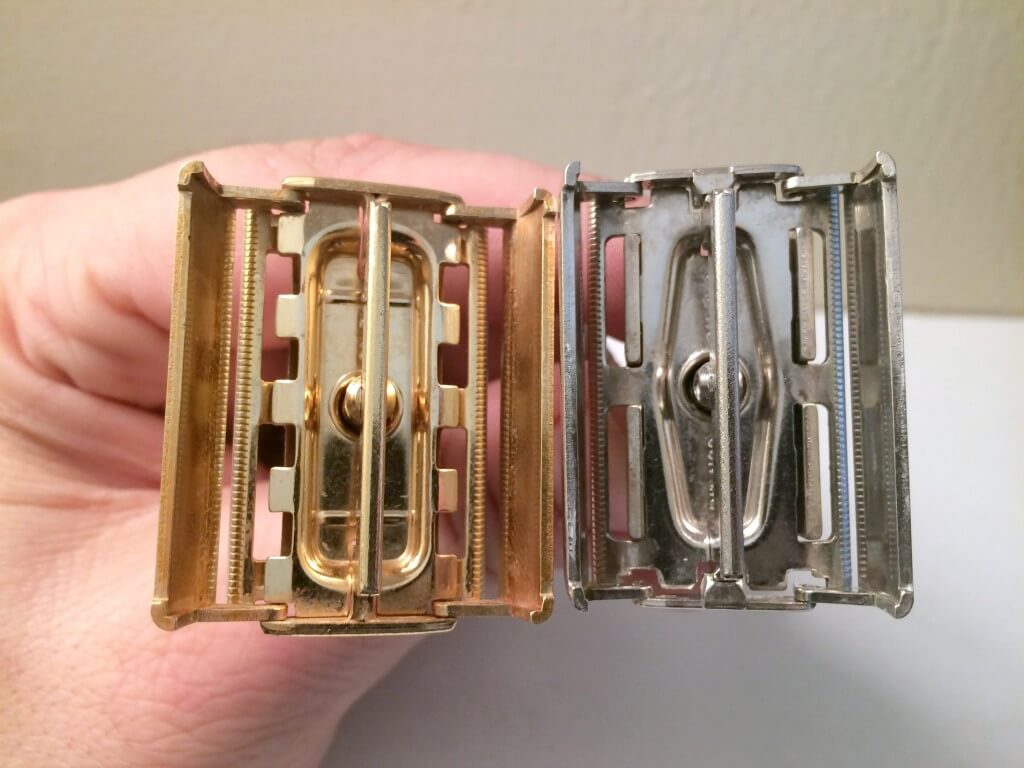
I found the added weight of the Toggle (Toggle 87 grams, Fat Boy 79 grams) not to have an effect on performance. The longer handle caused by the lever was a different story. At times it made my stroke a tad awkward and uncomfortable. I have used long handled razors before, but I felt the different shape of the lever made it difficult to use. This was not the case with the Fat Boy. The Fat Boy was comfortable and smooth. It was almost a natural fit for my hands.
After five or so shaves I fully understood why the Fat Boy succeeded the Toggle. The Fat Boy took the best features of the toggle while eliminating its faults. A product of innovation to say the least. Both razors performed remarkably well, even to today’s standards.
Conclusion
The Gillette Toggle’s mystery may never be completely solved but it’s easy to see why the razor is so collectable. It represents years of innovation, and the process of elimination for a razor that consumers really wanted. Gillette really put their homework into this concept and although it was not successful, it opened the door for a razor design that lasted for almost 30 years.
I’d like to give a special thanks to Greg McCoy of Procter and Gamble for his time and efforts to making this article possible. I’d also like to thank the countless collectors who keep these razors preserved for future generations.
About the Author:
Joe Borrelli is a long-time wet shaving enthusiast and collector. He hosts the Wet Shaving News Podcast and runs his own self-funded website http://shavestraightandsafe.com/ to help inform the community of new information involving the wet shaving world. Joe holds a BBA from Florida Atlantic University, and currently works for the nation’s largest wine/spirits/beer retailer. In his spare time, he enjoys traveling with his wife Linda, reading, writing, outdoor activities and collecting wet shaving apparel. Find out more about Joe here.

was very fortunate that my 87-yr-old father-in-law never threw away anything that still worked – he gifted me his nearly pristine 1960 F4 Toggle and a NIB 1962 H3 Gillette Adjustable… i can’t bring myself to use the Toggle or the NIB razors, but fortunately found a number of other great user Gillettes, including a 1961 G2 (Version 4) Fat Boy… however, for me, the best Gillette shavers are the 1951/52 Tech razors, which are non-adjustable! these razors are not only great to use, they save you money, perform well, and give a good bit of satisfaction knowing that something made so long ago was a great idea at the start!
Great article and informative as well. My razor collection is pretty extensive but I’ve still not been able to obtain a toggle. I mostly look in antique shops and try to stay away from online purchases. They seem too expensive! I was in a little antique shop a couple of weeks ago and scored two Fatboys for $13.00! I’m still looking for the toggle!
Very informative article. I love the 195 Fatboy. I hope one day to own a Toggle as well.
great work! Many thanks for sharing.
Outstanding article. I did not realize there were so many varieties. I had one similar to the one at the to of the article. However, I eventually sold it. I preferred my Slim and Fat Boy – which cost a lot less.
Good article
Makes me want to look what they go for.
I might not want to know they go for.
Old classic razors had so much style and design. Now they are cheap plastic.
I have an old atra I keep in drawer. I stoped buying new razors when the cartridges got to be about $21 for 3 razors. I get a better shave from cut-throat or safety razor anyway.
Thank You Joe so much for this great Story! It did bring a tear to me eyes. Let me explain why. Just last week Feb. 2 My Mom give me a razor that She found in a box of old photos, saying “your collecting old razors, here is one from one of your Grandfathers” not knowing which Grandfather. So for the last 4 days I have been searching the internet/forums for info on this family heirloom. I quickly found the name of the razor and some confusing info about the years that it was made, a little info here and a little there, not the full story. I got to the part of Your story “First Test”, I quickly called Mom with a tear in my eyes “It’s Your Dad’s Razor”. My Grandfather Vint live in Milwaukee, he was a business man with a heavy dark beard, like me would get a 5 o’clock shadow at noon and would shave sometimes 2 times a day, he loved getting new razors and owned a hand full of razors. He passed away in early 1957, so razor was only use about 7-8 months max, it has only a little discoloration in the gold and no wear. So I’m the happy owner of the 1955 Gold Toggle ser# 1370, owned by the Grandfather I never knew. Again thank you
That is an amazing story. Good for you.
Jim
Doug,
What a great story and a wonderful coincidence of receiving the razor and having the razor article posted about the same time.
Comments are closed.